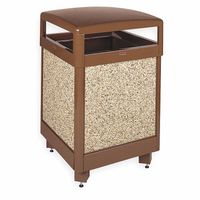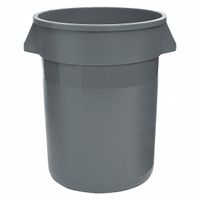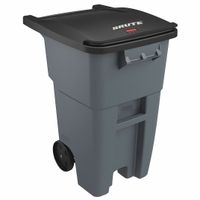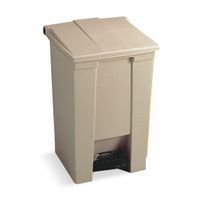Call +(254) 703 030 000 / 751 483 999 / 721 704 777
.....Read More
Frequently Asked Questions
What size trash can do I need?
To determine the appropriate size trash can, consider the following factors:
1. **Household Size**:
- **1-2 people**: A 7-10 gallon trash can is typically sufficient.
- **3-4 people**: A 12-16 gallon trash can is recommended.
- **5+ people**: A 20-30 gallon trash can may be necessary.
2. **Room Usage**:
- **Kitchen**: Generally requires a larger can, around 12-16 gallons, due to food waste.
- **Bathroom**: A smaller can, about 4-7 gallons, is usually adequate.
- **Office/Bedroom**: A 7-10 gallon can is often suitable.
3. **Waste Generation**:
- Consider how much waste you generate. If you frequently cook or entertain, opt for a larger can.
- For those who recycle or compost, a smaller trash can may suffice.
4. **Collection Frequency**:
- If trash is collected weekly, a larger can may be needed.
- For more frequent collection, a smaller can might be adequate.
5. **Space Availability**:
- Measure the space where the trash can will be placed to ensure it fits comfortably.
- Consider the can’s height, width, and depth.
6. **Aesthetic and Functional Preferences**:
- Choose a design that complements your decor.
- Consider features like lids, foot pedals, or wheels for convenience.
7. **Local Regulations**:
- Check if there are any size restrictions for trash cans in your area.
By evaluating these factors, you can select a trash can size that meets your needs efficiently.
How do I choose between plastic and metal trash cans?
When choosing between plastic and metal trash cans, consider the following factors:
1. **Durability**: Metal trash cans, typically made from stainless steel or aluminum, are generally more durable and resistant to dents and scratches. Plastic cans, while less durable, are resistant to rust and corrosion.
2. **Weight**: Plastic trash cans are lighter and easier to move, making them suitable for indoor use or areas where mobility is important. Metal cans are heavier, providing stability and making them less likely to tip over.
3. **Cost**: Plastic trash cans are usually more affordable than metal ones, making them a cost-effective option for budget-conscious buyers.
4. **Aesthetics**: Metal trash cans often have a sleek, modern look that can complement contemporary decor. Plastic cans come in a variety of colors and styles, offering more versatility in design.
5. **Maintenance**: Metal cans are easier to clean and maintain, as they do not absorb odors and are less likely to stain. Plastic cans may retain odors and require more frequent cleaning.
6. **Environment**: Consider the environmental impact. Metal cans are often more recyclable and have a longer lifespan, reducing waste. Plastic cans, while recyclable, may contribute to plastic waste if not properly disposed of.
7. **Usage Location**: For outdoor use, metal cans are preferable due to their durability and resistance to weather conditions. For indoor use, plastic cans are often sufficient and more convenient.
8. **Noise**: Metal cans can be noisier when opening and closing, while plastic cans tend to be quieter.
Evaluate these factors based on your specific needs and preferences to make an informed decision.
What are the benefits of using trash can liners?
Trash can liners offer several benefits:
1. **Hygiene**: Liners prevent direct contact between waste and the trash can, reducing the spread of germs and bacteria. This is crucial in maintaining a clean and sanitary environment, especially in kitchens and bathrooms.
2. **Odor Control**: Liners help contain unpleasant odors from waste, keeping the surrounding area smelling fresh. Some liners are even designed with odor-neutralizing properties.
3. **Ease of Disposal**: Liners make it easy to remove and transport waste. By simply tying the liner, you can securely contain the trash, minimizing the risk of spills or leaks during disposal.
4. **Protection of Trash Cans**: Liners protect the interior of trash cans from stains, residue, and damage caused by wet or sharp objects. This extends the life of the trash can and reduces the need for frequent cleaning.
5. **Convenience**: Using liners simplifies the process of waste management. They are easy to replace and can be quickly tied and removed, saving time and effort.
6. **Versatility**: Liners come in various sizes and materials, making them suitable for different types of waste and trash cans. This versatility ensures that they can be used in a wide range of settings, from homes to offices to industrial sites.
7. **Environmental Considerations**: Many liners are now made from biodegradable or recycled materials, offering an eco-friendly option for waste management. This helps reduce the environmental impact of plastic waste.
8. **Aesthetic Appeal**: Liners help maintain a neat and tidy appearance by concealing unsightly waste. This is particularly important in public or shared spaces where cleanliness is a priority.
How do I prevent trash cans from smelling?
1. **Use Liners:** Always use trash bags or liners to contain waste and prevent leaks.
2. **Regular Cleaning:** Clean the trash can with soap and water regularly. Use a disinfectant or vinegar solution to kill bacteria.
3. **Baking Soda:** Sprinkle baking soda at the bottom of the trash can to absorb odors.
4. **Charcoal:** Place activated charcoal at the bottom to neutralize smells.
5. **Essential Oils:** Add a few drops of essential oils to a cotton ball and place it in the trash can for a pleasant scent.
6. **Dry Waste:** Ensure waste is dry before disposal. Drain excess liquids from food waste.
7. **Compost:** Separate compostable materials to reduce odor-causing waste in the trash can.
8. **Citrus Peels:** Add citrus peels to the trash to naturally combat odors.
9. **Regular Disposal:** Empty the trash can frequently to prevent buildup of odor.
10. **Odor Absorbing Products:** Use commercial odor-absorbing products or deodorizers designed for trash cans.
11. **Ventilation:** Keep the trash can in a well-ventilated area to allow odors to dissipate.
12. **Tight Lid:** Use a trash can with a tight-fitting lid to contain smells.
13. **Freezer Storage:** Temporarily store particularly smelly waste, like meat scraps, in the freezer until trash day.
14. **Coffee Grounds:** Use dried coffee grounds at the bottom of the trash can to absorb odors.
15. **Newspaper:** Line the bottom with newspaper to absorb liquids and odors.
What is the best way to clean a trash can?
1. **Preparation**: Wear gloves and a mask for protection. Move the trash can to a well-ventilated area, preferably outside.
2. **Empty the Can**: Remove any remaining trash and debris. Check for stuck-on waste and scrape it off with a spatula or brush.
3. **Rinse**: Use a hose to rinse the inside and outside of the trash can. This helps remove loose dirt and grime.
4. **Apply Cleaning Solution**: Use a mixture of water and dish soap, or a solution of water and vinegar. For tough odors or stains, add baking soda or use a commercial cleaner.
5. **Scrub**: Use a long-handled brush or sponge to scrub the interior and exterior. Pay special attention to corners and the bottom where residue accumulates.
6. **Rinse Again**: Thoroughly rinse the trash can with a hose to remove all soap and residue.
7. **Disinfect**: Spray or wipe down the trash can with a disinfectant spray or a bleach solution (1 part bleach to 9 parts water). Let it sit for a few minutes to kill bacteria.
8. **Final Rinse**: Rinse the trash can one last time to remove any remaining disinfectant.
9. **Dry**: Turn the trash can upside down and let it air dry completely. Ensure it is fully dry to prevent mold and odors.
10. **Deodorize**: Once dry, sprinkle baking soda at the bottom to absorb future odors. Alternatively, use a trash can deodorizer.
11. **Replace Liner**: Insert a new trash bag or liner to keep the can clean longer.
12. **Regular Maintenance**: Clean the trash can regularly to prevent buildup and odors.
How do I secure trash can lids to prevent animals from getting in?
1. **Use Animal-Proof Lids**: Purchase trash cans with locking lids specifically designed to deter animals. These often have a latch or snap mechanism.
2. **Bungee Cords**: Secure the lid with bungee cords. Loop the cord through the handle on the lid and attach it to the handles on the sides of the can.
3. **Heavy Weights**: Place a heavy object, like a brick or a rock, on top of the lid to make it difficult for animals to lift.
4. **Rope or Chain**: Tie the lid down with a strong rope or chain. Ensure it is tightly secured to prevent animals from prying it open.
5. **Trash Can Enclosures**: Build or buy an enclosure for your trash cans. This can be a wooden or metal structure that surrounds the cans, adding an extra layer of protection.
6. **Motion-Activated Sprinklers**: Install motion-activated sprinklers near your trash cans. The sudden spray of water can deter animals from approaching.
7. **Repellents**: Use animal repellents around the trash area. These can be commercial products or natural options like vinegar or ammonia.
8. **Secure Location**: Place trash cans in a garage or shed if possible, especially overnight when animals are most active.
9. **Regular Cleaning**: Keep trash cans clean to minimize odors that attract animals. Rinse them out regularly and use trash bags to contain waste.
10. **Timely Disposal**: Put trash out for collection as close to pickup time as possible to reduce the time it is accessible to animals.
Are there specific trash cans for recycling purposes?
Yes, there are specific trash cans designed for recycling purposes. These recycling bins are distinct from regular trash cans and are often color-coded or labeled to indicate the type of recyclable materials they are intended to collect. Common colors include blue for general recyclables, green for glass, and yellow for plastics, though these can vary by region.
Recycling bins are typically marked with the universal recycling symbol and may have additional labels specifying the types of materials accepted, such as paper, cardboard, metals, plastics, or glass. Some recycling systems use multi-stream bins, where different materials are separated at the source, while others use single-stream bins, where all recyclables are collected together and sorted later at a recycling facility.
These bins are strategically placed in public areas, offices, schools, and homes to encourage recycling and make it convenient for people to dispose of recyclable materials properly. In some cases, recycling bins have specific openings designed to accept only certain types of items, such as slots for paper or round openings for bottles and cans, to minimize contamination.
The use of designated recycling bins is an essential part of waste management systems aimed at reducing landfill waste, conserving natural resources, and promoting environmental sustainability. Proper use of these bins helps ensure that materials are effectively recycled and reduces the risk of contamination, which can render recyclable materials unusable.




